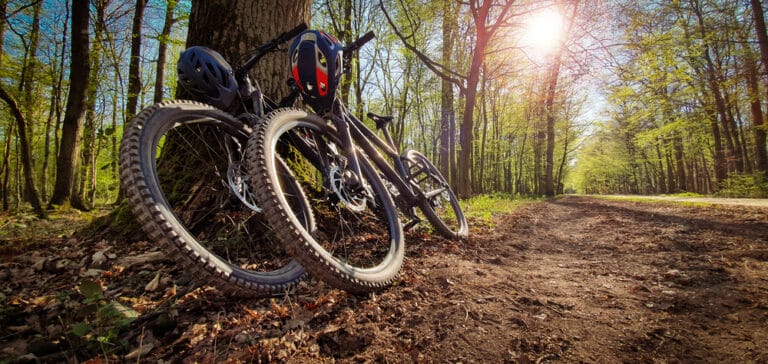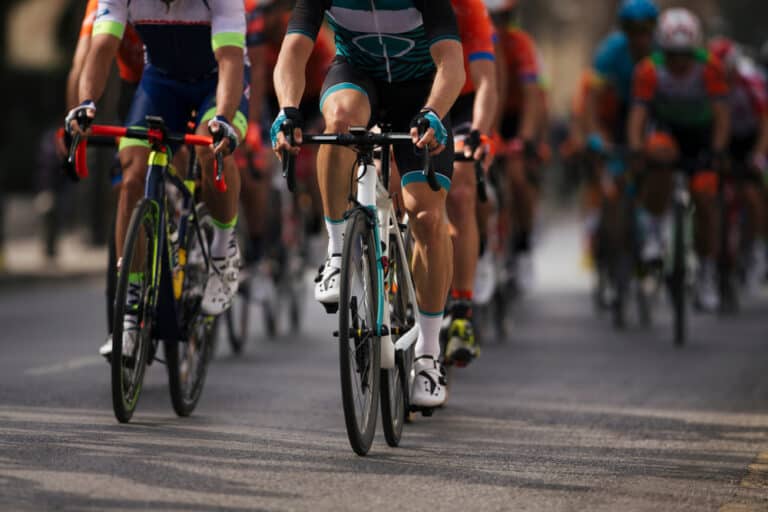How Much Faster Is Biking Than Running?

Editorial credit: YuryKara / Shutterstock.com
Most people will know that biking is faster than running, but the question is, how much quicker are two wheels than two legs over the same distances and how many more calories are burned biking at different speeds vs. walking?
The average running speed for amateur men over flat terrain is around eight mph, and for women, that speed is about 6,5mph. When you consider that an average biking speed would be approximately 12-14mph for amateur riders over flat ground, biking is about twice as fast as running.
Even though it is clear that biking is faster than running, the question remains as to how much quicker it is and how these stats change when we look at the world of professional athletes! Let’s get on the road and explore the speeds and energy involved with biking and running.
How Much Faster Is Biking Than Running Over Five Miles?
For comparative purposes, we will look at the time needed to cover 5 miles and then 10 miles by average riders and runners and then compare that to the speeds elite athletes can deliver in both disciplines.
To run five miles at an average speed of 8mph would take about 38 minutes. If you bumped that running speed up to 10mph (if you were fit enough to run 5 miles at that speed), that same distance would take just 30 minutes, and you would be working hard to achieve that.
If you were biking five miles at eight mph, the time would be the same, but the effort required would be far less, and you would be less tired riding than running. If you increased that speed to a mediocre 12mph, it would take 25 minutes to cover that distance.
At 14mph, considered an average riding pace, you would make that distance in just 21 minutes, and sprinting at 20 mph, you would need just 12,5 minutes to cover five miles. Running 5 miles would require more exertion than biking five miles.
Even at a fast ten mph running pace, biking the same distance at an average pace would mean you complete that distance in 17 minutes less.
How Much Faster Is Biking Than Running Over 10 Miles?
Doubling the distance and comparing running and biking speeds reveal an even greater disparity between the two disciplines. The real consideration is the effort and energy required to complete 10 miles on foot and wheels.
Biking 10 miles will leave you a lot less tired than running 10 miles, so let’s first look at how much faster biking would be than running over this distance, and then we will look at the calories burned with each activity.
Averaging eight mph, it would take an hour and 15 minutes to complete the distance, while pushing that speed to 10mph would reduce the time to just 60 minutes. Biking at an easy pace of 10mph would cover the distance in one hour, and at 12mph, this time would be cut to 50 minutes.
At 15mph, which would fall in the average biking speed range, covering 10 miles would take just 40 minutes. Comparing average running and biking speeds shows that biking the same distance would give you a 35-minute time advantage over the average paced runner.
Which Burns More Calories- Biking Or Running?
While it may seem that biking burns more calories than running, the converse is true! Unlike walking, which doesn’t require the same effort as running, picking up the pace on your feet will burn more calories over the same time than biking at an equivalent pace.
Let’s compare the calories burned by an average runner of 154lbs over 30 minutes and 60 minutes against cycling at the equivalent pace over the same periods.
The runner’s pace will be set at five mph, a moderate pace, while the cycling pace will be ten mph. Over 30 minutes, a runner would burn an impressive 295 calories, while biking at ten mph for the same period would only burn 145 calories.
This is less than HALF of the calories burned running over the same period! If we expand that to 60 minutes, the runner will burn 590 calories, while biking would only burn 295 calories over the same period!
This again is half the amount of calories burned running than biking, but remember that you can ride a bike for much longer than you can run – but the facts remain! While it would take less time to ride than running the same distance, you would burn DOUBLE the calories running over 30 and 60 minutes than you would biking!
As you can see, you will burn more calories per mile if you are running than biking, but you will be able to cover more distance on your bike than you could when running, and this would balance out the equation if you are looking to lose weight.
How Much Faster Is Biking Than Running For Professional Sprinters?
When it comes to the top athletes in these fields, are the stats the same? And we also have to consider sprinting speed for riders and runners, but let’s start with long-distance running, and we’ll examine the speeds involved in racing.
The average sprinting speed for most athletes is around 15mph, but elite athletes can achieve speeds of 26 mph at top speed! Remember that this is over short distances of 100m, 200m, and 400m and not over five or ten miles.
While professional cyclists also only sprint over short distances, their sprinting speeds average around 40mph, 14mph faster than running, which is about 35% faster. Of course, bikes have gears and more momentum, and riders can deliver much more power through the crank than runners can do through their feet to the road.

How Much Faster Is Biking Than Running Over 26 Miles?
As the standard distance for marathons, let’s look at the comparative speeds for biking and running over this distance. An elite professional runner would complete a marathon in just over two hours, producing an average speed of around 13mph.
If you take the average speed of a pro cyclist at 25 mph, then the same distance would be covered in just over an hour or sixty-two minutes, which would be half of the time that a professional runner would do.
So, the pro cyclist would be done, dusted, and have their feet up for an hour before the first runner crossed the line. If you aren’t into spending hours on the road running over distances, then biking is definitely for you as it would take you half the time.
Biking Is Faster- But Running May Be Better For Your Bones
Bone density is an area where running has the edge, and this is because cycling is a very low-impact sport compared to pounding on the road. As we age, bone density tends to decrease, and maintaining it at some level has long-reaching health benefits.
You don’t need to run at a great pace to enjoy this benefit, but it certainly does outdo biking in this respect,so a mix of cardiovascular exercise and overall health would be ideal. Despite this health benefit, there is no question that biking is faster than running, but when it comes to burning calories, running is superior.
What’s The Fastest Speed Achieved On A Bike And Running?
As a matter of interest, you can see how much faster biking is than running by looking at the fastest speeds recorded on a bike and the road or track. For this example, we are not looking at downhill racing but speeds achieved in road racing or track sprints.
It will be no surprise that Usain Bolt holds the current record at 27,78mph, and scientists theoretically postulate that humans could reach speeds of 30mph if their muscle fibers could contract fast enough.
The fastest speed on a bicycle was achieved in 2018 when Denise Mueller-Koronek reached 183mph at the Bonneville Salt flats, but she was hooked to a racing car before releasing and achieving the land speed record.
This is extreme, though, and you aren’t going to see speeds like that in the Tour De France anytime soon. Regardless, riders can reach speeds of 45 mph on flat roads and downhill; those speeds can reach 65 mph heading down some of those mind-boggling descents!
Compared to Mr. Bolt’s top speed of 27mph, the 45mph self-powered speed of pro riders is 67% faster than that and is not to be sneezed at, although it may be interesting to see how fast Usain would be on a bike!
Conclusion
Whether running uphill, downhill, or on a flat track at average or higher than average speeds, if you were racing a bike, you would come second almost every time, but this was to be expected from the outset.
There is no comparative scenario where running is faster than biking, and running might burn more calories per mile and bone-density benefits; if you want to go faster and cover the distance in less time, you need to get on a bike.






